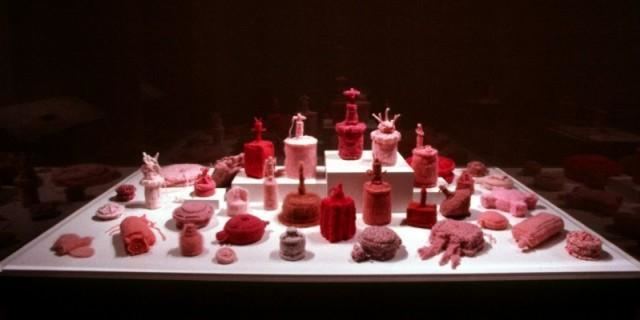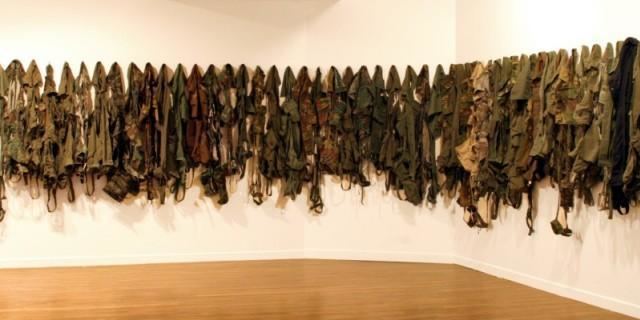Name Barb Hunt | ||
 | ||
Artist talk barb hunt
Barb Hunt is an interdisciplinary textile artist based in Corner Brook, Newfoundland. Her work has been about the devastation of war: knitting antipersonnel land mines in pink wool and creating works from camouflage army uniforms. Such work contrasts knitting as a warming, protective art, against the violence of war. Her work has also reflected on her Canadian identity.
Contents
- Artist talk barb hunt
- Early life and education
- Career
- Land Mines series
- Camouflage series
- Mourning series
- Steel Dresses series
- Other
- References

A feminist, Hunt has also created large cut steel dresses and a series of embroidered sayings about women on 1940s-1950s sheer aprons. Some of her series focused on the rituals of mourning, particularly those of Newfoundland. These involved huge collections of cemetery flowers, traditional shroud cutwork, black lace and sea-worn quartz stones from Newfoundland beaches.
Hunt says about her work: "In my art practice, I attempt to mend separations, and to reveal and recuperate the "feminine" which historically has been discredited. By giving value to the humble, the discarded and the hand-made, I hope to recover lost histories and encourage the re-consideration of traditional rituals within a contemporary context."
Early life and education
In a 2013 talk given for the Wendy Wersch Memorial Queen's UniversityLecture Series in Winnipeg, entitled We are all of us made by war, Hunt described how her grandmothers made quilts and her mother taught her craft.
Hunt received her undergraduate degree from the University of Manitoba School of Art in Winnipeg in 1982. She completed her post-graduate studies at the Concordia University in Montréal, Québec in 1994. From 1995-1996, Hunt taught at the University of Western Ontario in London, Ontario. Between 1997 and 2001 she taught at Queen's University in Kingston, Ontario. Hunt has taught in the Visual Arts Program, Grenfell Campus of Memorial University of Newfoundland in Corner Brook in 1996-1997, and permanently from 2001. In 2015, she inaugurated their first textile-based course.
Career
Hunt's work has shown in high-profile solo and group exhibitions across Canada and internationally. She has also received residencies in Canada, Paris and Ireland. Her art is in several scholarly journals, such as:
Land Mines series
In the group exhibition, Museopathy, in London, Ontario in 2001 (curated by DisplayCult), Hunt explored feminisations of war weaponry. A solo show of her Antipersonnel series followed at the Art Gallery of Ontario in 2001. This series comprises dozens of pink knitted landmines, creating a contrast between materials and the destructive subject matter, while also referencing the connections of women knitting for soldiers overseas.
Camouflage series
In Toll, her 2011 solo show at The Rooms in St. John's, Newfoundland, she used camouflage fabric as a central theme and material. Hunt’s art considers the human costs of armed conflict balanced by a deep empathy for individuals, including soldiers, in areas of hostility. This work reflects upon depicting the absurdity of war.
Mourning series
This body of work expresses relationships between death, mourning, gender and recuperation. Hunt has studied the close cultural ties between Newfoundland and the islands of Ireland and the United Kingdom. As a descendant of Irish/English settlers, Hunt's female relatives taught her some of the textile skills expected of women. After the death of her father, she found herself involved in highly repetitive textile work as a way of mourning. This labour-intensive craft seems to be a common way of coping with grief and loss, and cloth has strong associations with protection and healing.
Steel Dresses series
Hunt made each metal dress in this series from a single sheet of cold-rolled steel. Using a plasma-arc cutter, she created delicate forms resembling textile patterns, images from nature and forms traditionally part of women's cultures. Hunt is particularly drawn to feminism's acceptance of domestic activities as a valid approach to contemporary art practice. Thus, she considers the making of these steel dresses as “sewing with fire”.
Other
Hunt is a member of the Manitoba Crafts Council and the Craft Council of Newfoundland and Labrador.
